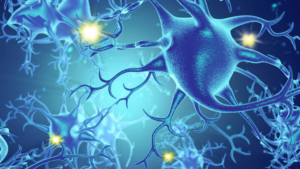Shingles (aka herpes zoster) are rashes that occur in any part of the body. This rash often comes up in people aged 50 and over, causing severe pain. Shingles also appear like blisters on the dermatome’s skin area. But, what exactly causes shingles, and how can we best manage them?
What Causes Shingles?
Shingles is a skin disease caused by the varicella-zoster virus. If you had chickenpox or took its vaccine, you might get shingles. That’s because the shingles vaccine contains chickenpox cells.
Chickenpox may disappear over time. But, the virus lingers in the brain and spinal cord tissues. So, the sleeping virus may reappear as shingles after some years.

How Shingles Affect the Nervous System
How Do Shingles Reactivate in the Nervous System?
The shingles virus stays dormant in the nerve tissues. If your immune system grows weaker, the virus reactivates.
As the virus becomes active, it spreads through the spinal cord nerves to the skin. These nerves convey messages of pressure, itching, and pain.
These messages transfer from the spinal cord to the brain. Once the varicella-zoster virus gets to the nerve endings, it shows up as a skin rash.
How Do Shingles Affect the Nerves?
As the virus travels along the nerves, it causes severe pain. This occurs even after the rash disappears. Still, many people may no longer feel the pain after two to four weeks.
Common effects of herpes zoster on the nerves include:
Movement Difficulty
Shingles can inflame your motor nerves, which affects muscle movement. As the condition develops, it weakens the muscles around the rash area. About 1 to 5 percent of people with herpes zoster have muscle weakness.
Pain or Postherpetic Neuralgia
Postherpetic neuralgia is an intense pain that lingers after the rashes heal. This condition occurs in about 18 percent of people with shingles. Postherpetic neuralgia disappears within a year, but some never recover.
Facial Nerve Damage
Shingles can also affect the head nerves. Signs of this condition include:
- Dry eyes
- Ear pain
- Tinnitus
- Paralysis on one side of the face
- Issues with taste
- Loss of hearing
- Ear blisters
- Vertigo
Other Common Symptoms of Shingles
Besides pain, other signs of shingles include:
- Fever
- Fatigue
- Numbness
- Itching
- Reddish rash
- Blisters
- Sensitivity to brightness
- High response to touch
- Headache
How to Best Manage Shingles Pain?
Pain from shingles is often intense, but there are things you can do to minimize it. These include:
- Engaging in exercise
- Eating balanced diet
- Regular resting
- Wearing silk or cotton clothing (to reduce irritation)
- Applying ice to the sores
Can Shingles be Treated?
Yes. Vaccination and early treatment can reduce the risk of complications. Failure to treat in time results in postherpetic neuralgia. This condition happens long after the blisters heal.
Getting shingles usually means that your immune system is not in its best condition. A healthy lifestyle like exercise, rest, and balanced diets can help with that.
If you want the best approach to your shingles recovery, fill out this form. Schedule an appointment today so that you can live a pain-free life tomorrow.
Fibromyalgia is a chronic condition characterized by widespread pain, fatigue, and other symptoms. It’s estimated that one in every fifty people will develop the disorder at some point in their lives. But what exactly is fibromyalgia? And how does it affect your body? Let’s take a look at the science behind this mysterious condition.
What is Fibromyalgia?
Fibromyalgia (FM) is a disorder that causes widespread pain throughout the body. The Mayo Clinic describes FM symptoms as “aching, burning or tenderness in your muscles, tendons, and joints”. Fatigue, sleep disturbances, and memory problems are also common. And while most people experience these symptoms on some level, those with FM report that their pain is significantly worse than the reported “average” person.
Although doctors are yet to discover the exact cause of fibromyalgia, most believe it’s likely a combination of physical, psychological, and environmental factors which trigger this disorder. These include genetics (family history), infections, and psychological stress.

The Science of Fibromyalgia
The Science Behind Fibromyalgia Symptoms
Once you (or someone close to you) is diagnosed with FM it can be difficult to understand how all of your symptoms can be related. After all, what do “muscle tenderness” and “insomnia” have in common? Well, it turns out there are several physiological factors that could play a role in these seemingly unrelated conditions.
Muscle Tenderness
Studies have indicated that a dysfunction of the central nervous system plays an important role in pain perception for those diagnosed with FM. While it’s not known why this occurs, one popular theory suggests that certain systems within the brain “malfunction”, causing them to send out amplified signals of pain to other parts of the body.
Sleep Disturbances
As for sleep disturbances, studies have suggested that dysfunction within serotonin may play a role in FM symptoms. Serotonin is thought to influence arousal and sleep, and those diagnosed with this disorder often have low levels of serotonin. While certain drugs are currently being used to boost levels of this neurotransmitter, more research is needed to understand the complex role serotonin plays in this condition.
Psychological Factors
In addition to these physiological factors, psychological factors often play a significant role in FM symptoms. In fact, it’s estimated that over 95% of those diagnosed with fibromyalgia also suffer from some form of depression or anxiety. And while it’s difficult to determine whether these disorders cause fibromyalgia or vice versa, it’s likely that they interact with one another in a “vicious cycle” of symptoms.
Fibromyalgia Diagnosis
While there is no single test for fibromyalgia, your doctor will likely perform a variety of tests to rule out other conditions before diagnosing you with this disorder. The process can often be lengthy – it’s not uncommon for a patient to visit their doctor several times and undergo multiple tests before receiving an official diagnosis.
For example, your medical history will likely be considered as well as your symptoms. Along with these questions, your doctor may test reflexes and muscle strength, check your joints for signs of swelling, measure your body temperature and also check blood levels of various hormones.
Treatment of Fibromyalgia
Once fibromyalgia has been diagnosed it can sometimes be challenging to treat. While some individuals find relief with medication and lifestyle changes there is no “cure” for this disorder. However, by understanding the underlying cause of your symptoms, you can identify triggers and make changes to reduce them.
Some lifestyle changes that may help include exercise, stress management, diet changes, and appropriate medication.
Exercise
Exercise has been shown to decrease fatigue associated with fibromyalgia while also reducing pain. It’s also thought that regular exercise helps combat the impact of depression on your body. Depending on the severity of your condition, you should consult your doctor before engaging in a new exercise routine.
Stress Management
Stress management is another important aspect of fibromyalgia treatment as stress can exacerbate symptoms. While this isn’t always easy, there are several strategies you can use to reduce your stress including relaxation exercises, meditation, and deep breathing.
Dietary Changes
Diet changes may also help. In some cases, certain foods may worsen symptoms as well as interact with medications you take to relieve fibromyalgia. Common food triggers include wheat, dairy, alcohol, caffeine, and sugar. It’s also important to avoid foods that have been artificially sweetened or that contain red dye #40 – these can cause a wide variety of adverse reactions for those diagnosed with this disorder.
Medication
In addition to dietary changes, medications may be prescribed to help combat sleep disturbances and pain. In particular, sleep aids can often help improve the quality of your shut-eye. Medications may also be employed for temporary relief from pain, while antidepressants can decrease symptoms associated with depression or anxiety.
Conclusion
While there’s no cure for fibromyalgia, by taking the appropriate steps to address symptoms, you can improve your quality of life. With the help of your doctor, you’ll be able to identify triggers and craft a plan that can assist you in coping with this chronic condition.
Rotator cuffs are a group of tendons and muscles that allow your shoulder mobility. These cuffs also help in stabilizing your shoulder. Additionally, rotator cuff injuries vary greatly from one another, and the symptoms may also vary.
Some of the most common injuries may include bursitis, rotator cuff strains, and tendinitis. These injuries can range from severe to mild. If you’re an athlete or a sportsperson who uses their rotator cuff quite frequently, then the most likely injury you may get is tendinitis. That’s because overuse of these muscles and tendons can lead to inflammation. Most basketball players, tennis players, and painters fall in this category.

How to Treat Rotator Cuff Injuries
You may experience rotator cuff strain from accidents, falls, and other sudden movements. Typically, most acute injuries involving the shoulder can lead to a partial tear or even a complete one in the tendons. Moreover, overuse can also cause this type of strain.
As for bursitis, this is inflammation in the bursa. These fluid- filled sacs between your bones and tendons can be inflamed for various reasons, including degenerative use.
Can You Treat a Rotator Cuff Tear or Strain at Home?
Home remedies can help you get relief from rotator cuff strain. However, it’s still important to visit your doctor if your symptoms persist for longer than a week. Your physician can help determine the severity of the injury, the type of rotator cuff injury and come up with the right prescriptions for you. The most common solutions are:
- Using over-the-counter medication for pain
- Using an ice pack on the area (hot packs are good too)
- Using a sling to avoid motion on the shoulder and resting it
- Injecting cortisone to reduce inflammation
- Exercising the affected shoulder
You should also note that depending on how bad the injury is, you may need surgery. However, the timing of the surgery will not necessarily affect the outcome.
What Are the Symptoms to Look Out For?
As mentioned before, while some types of rotator cuff injuries are generally characterized by immediate and intense pain, some may take longer to manifest. You may have a tear without even knowing it until it gets worse. Even so, there are tell-tale signs of such injuries. They include:
- Difficulties with moving the affected shoulder due to pain
- Difficulties in sleeping or lying on the affected shoulder
- Trouble reaching the back of your shoulder
- Pain in the area from time to time
- Inability to use full range motion of your shoulder
- Weakness in the shoulder which gets worse over time
Can You Prevent a Rotator Cuff Injury?
Injuries caused by an acute injury cannot easily be prevented as a most result from accidents. However, it’s possible to prevent other forms of injuries by exercising your shoulder frequently to improve its range of motion or simply strengthen it. You can also try taking frequent rest breaks if your occupation involves overusing your shoulder muscles.
Final Thoughts
Rotator cuff injuries can sometimes lead to excruciating pain. Although home remedies and preventive measures can help ensure you don’t strain your tendons, sometimes surgical intervention is necessary to help correct the tear. For more information, feel free to fill out the form below.
Chronic fatigue syndrome(CFS), also known as myalgic encephalomyelitis (ME) or systemic exertion intolerance disease (SEID), is a debilitating disorder often characterized by extreme fatigue that is long-lasting. This disorder is complicated in that it can neither go away with rest nor even be explained by an underlying medical condition. In addition, the causes of chronic fatigue syndrome are unknown, although theories are speculating about the possible causes of this disorder.
Having said that, the following is a breakdown to help you understand CFS and the possible treatments.

Pain Symptoms of CFS
Symptoms of Chronic Fatigue Syndrome
Although fatigue is a common symptom of chronic fatigue syndrome, it is worth noting that the symptoms may vary from one person to another. What’s more, the severity of the symptoms may fluctuate from day to day.
Other symptoms associated with CFS include:
- problems with memory or concentration
- Headaches
- Unexplained muscle or joint pain
- Unrefreshing sleep
- Frequent sore throats
- Tender and swollen lymph nodes in your neck and armpits
- Chronic insomnia
How is CFS Treated?
Despite comprehensive research, the complexity of this disorder has made it difficult to find a specific cure. In addition, people diagnosed with this condition exhibit different symptoms; therefore, different medications and treatment techniques are used to manage the symptoms. As such, before taking further steps, it is imperative to speak to your physician, who can advise you on the proper treatment to undertake.
That said, the following are some treatment options available helpful in managing the disorder and relieving the symptoms:
Medications
Some symptoms of CFS can be managed through prescription and over-the-counter drugs. For example:
Pain: can be addressed by taking medications such as ibuprofen and naproxen sodium. If over-the-counter medication doesn’t relieve the pain, your doctor may recommend medications used to treat Fibromyalgia.
Depression: Many people suffering from this disorder exhibit depression as one of the symptoms. This can be dealt with by taking antidepressants that can help relieve pain and, at the same time, reduce stress.
Therapy
Therapy is another treatment option for people with chronic fatigue syndrome. Putting it briefly, the benefits of therapy are immense as far as CFS is concerned. Therapy typically helps address:
Sleep problems: Your doctor may recommend a suitable sleep routine to the effect that it counters sleep disorders and, at the same time it helps deal with chronic pain.
Worsening conditions: Exercising as a regimen helps counter the debilitating symptoms of CFS and even the worsening conditions. As such, your doctor may advise you on the various exercises to undertake and how you should go about it.
Post-External Malaise
People with CFS often experience a worsening of their symptoms after undertaking either physical or mental activities. This is what is known as Post-External Malaise, and it can last for an extended period.
As such, CFS patients are advised not to do things overtly. Instead, they are required to maintain a balance between activity and rest. This can be achieved by keeping a daily diary of the activities and symptoms to help you stay on track.
Final Thoughts
Chronic fatigue syndrome can lead to immense pain. Often confused with Fibromyalgia, the disorder can be challenging to point out from the onset. Therefore, patients need to be diagnosed appropriately and ultimately subjected to the proper treatment to manage the symptoms.
Having said that, if you or your loved one suspect that you have chronic fatigue syndrome, it is essential to consult a doctor immediately. In essence, a qualified physician can recommend proper care and treatment.
Contact Progressive Pain Management today to learn more about Chronic Fatigue Syndrome and how our team can help with symptoms.


